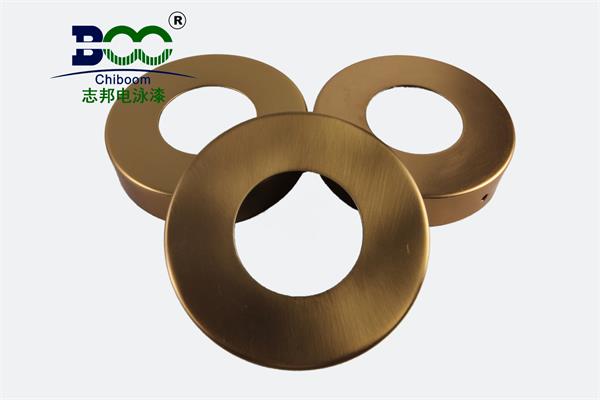Analysis of the Causes of Unevenness in Electrophoretic Paint
In the modern industrial coating field, electrophoretic paint is widely used in industries such as automobiles, machinery, and home appliances due to its excellent anti-corrosion properties and decorative effects. However, unevenness in the electrophoretic paint film often occurs during actual production processes. This not only affects the appearance quality of the product but may also have adverse effects on its protective performance. This article will delve into the common causes of uneven electrophoretic paint films to provide reference and solutions for relevant enterprises.

The causes of unevenness in electrophoretic paint films are multifaceted, involving factors such as the metal substrate, process design and operation, equipment maintenance, and the quality of the electrophoretic paint itself. First, the surface condition of the metal substrate has a direct impact on the uniformity of the electrophoretic paint film. During the processing of metal workpieces, microstructural unevenness may occur. For example, after hot rolling, the surface of castings may exhibit anisotropy. Such microstructural differences can lead to variations in electrical conductivity in different directions of the workpiece, thereby affecting the distribution of current density during electrophoresis and ultimately resulting in uneven paint film thickness. Additionally, if impurities such as oil, rust, or welding slag exist on the substrate surface, they will hinder the uniform adhesion of the electrophoretic paint. During the pre-treatment stage before electrophoresis, if processes such as degreasing, derusting, and phosphating are not performed properly, residual chemical substances or impurities may react with the electrophoretic paint, disrupting the uniformity of the paint film.
Process design and operational issues are also significant factors contributing to uneven electrophoretic paint films. The parameter settings of the electrophoretic bath liquid are a critical aspect affecting paint film uniformity. Voltage is the primary driving force in the electrophoresis process. If the voltage is set too high, the paint film deposition rate will be too fast, leading to excessively thick local paint films. Conversely, if the voltage is too low, the paint film deposition will be insufficient, resulting in uneven thickness. The temperature of the electrophoretic bath liquid is equally crucial. Excessive temperature accelerates the aging of the bath liquid, increasing the curing rate of the paint film, which may lead to defects such as orange peel and pinholes on the paint film surface. Insufficient temperature, on the other hand, degrades the leveling properties of the paint film, affecting its appearance quality. The solvent content in the bath liquid should also not be overlooked. Excessive solvent content reduces the viscosity of the paint film, leading to sagging; while insufficient solvent content makes the paint film too dry, affecting its flexibility and adhesion. The design and use of hangers also influence the uniformity of electrophoretic paint films. Hangers must have good electrical conductivity. If the hangers conduct poorly or are loosely attached, uneven current distribution will occur, thereby affecting paint film thickness. Furthermore, the spacing and hanging intervals of hangers should be reasonably set. Too narrow spacing will concentrate current in specific areas, leading to uneven paint film thickness. During electrophoresis, the circulation speed of the bath liquid and the angle of the nozzles should also be optimized. Insufficient or uneven circulation speed will cause uneven distribution of the paint liquid in the bath, affecting paint film uniformity; while an unreasonable nozzle angle will result in uneven paint application, leading to stripes or blotches on the paint film surface.
Inadequate equipment maintenance and management are also reasons for uneven electrophoretic paint films. The maintenance condition of electrophoretic equipment directly affects the quality of the paint film. If key components such as spray guns and nozzles are not cleaned and maintained for extended periods, nozzle clogging or uneven spraying may occur, further affecting paint film uniformity. Additionally, the cleanliness of the electrophoretic tank cannot be ignored. If impurities or sediment accumulate in the tank, they will contaminate the bath liquid and affect paint film quality. Regular cleaning of the electrophoretic tank to remove debris and sediment is an essential measure to ensure paint film quality.
The quality of the electrophoretic paint itself should also not be overlooked. The stability of electrophoretic paint quality is the foundation for ensuring paint film uniformity. If the formulation of the electrophoretic paint is unreasonable, with an improper ratio of pigments to resin, the physical properties and adhesion of the paint film may decline, thereby affecting its uniformity. Moreover, if the electrophoretic paint undergoes stratification or sedimentation during storage, its stability will deteriorate, leading to issues such as uneven color and particles during coating. Therefore, selecting high-quality, stable electrophoretic paint and strictly adhering to storage requirements are crucial for ensuring paint film quality.
In summary, the causes of unevenness in electrophoretic paint films are multifaceted, involving the metal substrate, process design and operation, equipment maintenance, and the quality of the electrophoretic paint itself. Enterprises should address these aspects by strengthening quality control and equipment management during production, optimizing process parameters, and selecting high-quality electrophoretic paint products to improve the uniformity and stability of electrophoretic paint films.




 WeChat
WeChat